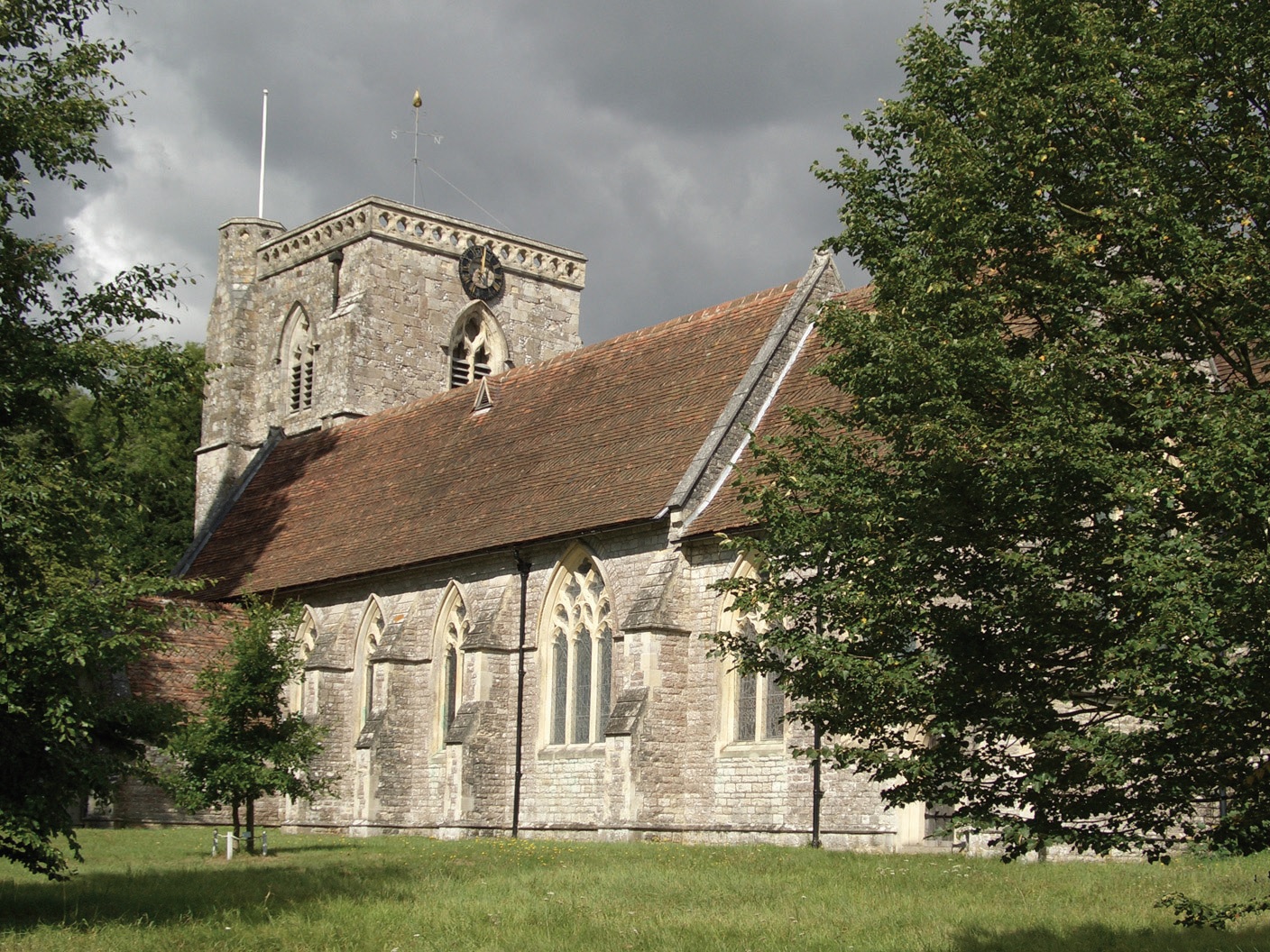 |
The bells of Hursley (which benefice possesses such an interest as having been held by the author of The Christian Year), have lately been restored. The old five bells had been badly hung (probably by some village carpenter or smith) many years ago. They have now been re-hung by Messrs. Hooper and Stokes, of Woodbury, Devon. A new treble bell, by Messrs. Mears and Stainbank, of the old foundry, Whitechapel, has been added; the ringing-chamber has been raised in height and put into order. Seage’s silent apparatus has also been affixed.
On Feb. 11th, the Winchester Cathedral ringers rang some Grandsire Doubles, the first that are known to have been rung in the tower.
The Bell News and Ringers’ Record No. 2, March, 1881, page 9
Hursley.- A meeting was held at this tower on Wednesday, April 30th, to unveil a board commemorating the first 720 of Minor rung by the local band on the bells. The board however, which is of polished mahogany, with a walnut and light oak moulding in Gothic style, and written in gold, had not arrived from the writers, much to the regret of those present. Members of the Winchester Cathedral (2), Romsey (3), Twyford (2) bands were present, together with Messrs. J. W. Whiting (Fareham), G. Chappell (Wickham), and W. Cooper (Swanmore), who had come over for the occasion. The ringing opened with a 720 of Grandsire Minor. Rev. H. Wheat, W. Jones, W. Cooper, W. Andrews, G. Chappell conductor, J. W. Whiting. Followed by 120 Stedman Doubles G. Smith, Rev. H. Wheat, J. Elcombe, W. Andrews, J. W. Whiting, H. Westbrook. Another 720. J. Elkins, G. Smith, Rev. H. Wheat, W. Andrews, J. W. Whiting, W. Fowler. And 240 Grandsire Minor. W. Witcher, J. Richards, Rev. H. Wheat conductor, R. G. Hunt, W. Jones. H. Westbrook. And 720 Bob Minor. W. Cooper, F. Russen, G. Smith, J. Elcombe, G. Chappell conductor, J. W. Whiting. On Wednesday, April 23rd, 720 Grandsire Minor was rung by the local band, W. Jones conductor, this being his first 720 as conductor.
The Bell News and Ringers’ Record No. 1051, May 31, 1902, page 94
On Saturday, May 19th, the augmented peal of eight bells at Hursley, Hants, was dedicated, the service being conducted by the Rev. C. E. Matthews, vice-president of the Winchester Diocesan Guild, and Rural Dean of Lyndhurst. Mr. Matthews was formerly curate at Hursley, 1896-99, since which time he has been Vicar of Bursledon, and of Titchfield, and is now Vicar of Milford-on-Sea. In the course of the service and during the singing of the hymn, “The church bells ringing from the height,” the clergy and choir proceeded to the western tower. Here the Vicar (the Rev. J. R. Husband) asked the Rev. C. E. Matthews to dedicate the bells “to the glory and praise of God.” Mr. Matthews and the Vicar ascended the tower to the belfry, where the dedicatory prayers were said; also the prayer appointed by the Guild, after which three bob leads of Grandsire Triples were rung, while the choir and clergy returned to the chancel, the service being resumed. The Rev. C. E. Matthews then gave an excellent address, basing his discourse on the words, “There are so many kinds of voices in the world, and none of them is without signification,” 1 Cor. xiv. 10. Following the address, a hymn, “The sacred bells of England,” composed by the Rev. C. E. Matthews, was sung, and the service closed with the Blessing. Afterwards touches of Grandsire and Stedman Triples and Bob Major were rung.
Tea was kindly provided by the Vicar, ringers being present from Bishopstoke, Bindfield, North Stoneham, Romsey, Winchester, and the local band, and Mr. C. Dean from the Croydon Foundry.- Mr. W. T. Tucker apologised for the absence of Mr. G. Williams, Master of the Guild, and Mr. W. Andrews thanked the Vicar for his hospitality. Further ringing took place in the evening, including two courses of Treble Bob.
The new treble has been given by Sir G. A. Cooper, Bart., of Hursley Park, and the 2nd by Mr. F. W. Talbot, of Pitt, Hursley. The 3rd and tenor have been recast, and the latter is now 14 cwt. in F sharp, being 2 cwt. heavier than the old bell. Of the rest, the 4th and 5th were cast in 1835 by W. and J. Taylor, of Oxford, and the 6th and 7th in 1616. These two bells bear the inscriptions, respectively. “Prayse God. I.W.,” and “Give thanks to God. I.W.” The previous tenor was cast in 1713. The back six are hung in the old frame, which has been strengthened, the new trebles being in an iron frame. The whole work reflects great credit upon Messrs. Gillett and Johnston, who have executed the contract, and Hursley possesses one of the finest peals of eight for their weight in Hampshire.
The Ringing World No. 637, June 1st, 1923, page 343
The tower of the present Church of All Saints, Hursley, is the only part remaining of the mediæval church built probably by William Edyngton, Bishop of Winchester, 1346-67, or his successor, William of Wykeham, 1367-1404. The present church is the third on the site. It was built in 1848, replacing a brick building which in turn replaced a yet earlier church thought to be Norman in about 1750. The present church was built by the Rev. John Keble from the proceeds of two books, the Lyra Innocentum and the Christian Year, and cost £3,380 for the structure and £1,200 for the woodwork, flooring and other interior fittings. This sum was exceeded and augmented by offerings from various friends. As part of this work, the tower which had survived the two previous churches was faced in the same Gothic style as the new church. It was surmounted by an elegant spire at a cost of £800 and was unfortunately removed in 1960.
The history of the bells is somewhat vague because almost all the old church records have been destroyed in recent years. The present bells Nos. 8 and 9 were cast by John Wallis of Salisbury in 1616; a tenor of about 12 cwt was added in 1713 by Will and Rob Cor; then the present 6 and 7 in 1835 by W & J Taylor of Oxford. They became six in 1880 when, to quote the Bell News, they were “rehung by Messrs Hooper and Stokes of Woodbury, Devon (in the present oak frame). A new treble bell by Messrs Mears and Stainbank of the old foundry Whitechapel had been added; the ringing chamber has been raised in height and put in order. Seage’s silent apparatus has also been afixed. On 11th February 1881 the Winchester Cathedral ringers rang some Grandsire Doubles - the first that are known to have been rung in the tower.”
The bells had to wait another nine years for their first peal, which was 5040 Minor in five methods; this peal was rung for the Sussex County Association and conducted by George Williams on 26th December 1890. The local band were quite active at this time as there are beautiful mahogany peal boards recording 720s of Grandsire Minor and Plain Bob rung in 1902 and 1903 respectively. The unveiling of the board for the 720 Grandsire Minor took place on 30th April 1902 and was recorded in the Bell News, as was the opening “peal” rung on the restored ring at nearby Sparsholt by the Hursley band. A surviving notebook records ringing for various events during the 1914-1918 War.
In 1923 the bells were augmented to eight by Messrs. Gillett and Johnston who hung two new trebles in a wrought-iron frame beside the wooden one. At the same time the 1890 treble and 1713 tenor were recast. All the bells were hung on ball-bearings - the back six retaining their wooden headstocks. In 1979 funds were raised by the band with which to rehang the back six; iron headstocks, wheels and all the other necessary parts were purchased from Whitechapel Bell Foundry and erected by some of the ringers. The first peal on the eight being rung on Saturday, 29th December 1923, of 5024 Double Norwich Court Bob Major in 3 hours 20 minutes, and again conducted by George Williams.
Emboldened by the success of this rehanging, a scheme for augmentation to ten was prepared, and after various disappointments the scheme was revived in 1987. The necessary funds were raised quite quickly, thanks to the organising genius of Philip Belgeonne. The work was entrusted to Whitechapel Bell Foundry and a small party went to London on 18th May to witness the casting of the new bells. Installation work started on 17th July and it was carried out by Philip Jakeman, Martin Waldron and volunteers from the band, taking three weeks to complete.
In the belfry a massive pre-fabricated steel frame was erected above an existing frame. The 1923 Gillett and Johnston frame was removed, galvanised and replaced, and the new trebles were hung in this frame and (using the new notation 1 to 10) the third went up into the new frame, the fourth below (in the former third’s pit), the fifth up above the sixth which was turned side-for-side and re-roped, as was the seventh; the eighth was roped from the other side of its wheel and a very good circle was formed.
An interesting point to note is that there is only 74 lbs weight difference between the treble and seventh bell.
The bells were first rung on Friday, 18th August, and were pronounced to be a perfect match. The new trebles are excellent specimens of the founder’s art, being finished in gleaming black lead. The treble has a most attractive moulding of a vine encircling it between the two top wires.
To date there have been 63 peals at Hursley, one on the six and 62 on the eight, 51 of them being rung since 1971 when the present band started to form.
After much last-minute activity, the ringing room looked magnificent with new paint and polish and all the peal boards back in their rightful places, the trophy for the Winchester District six-bell striking competition and village general knowledge quiz in a prominent place. A framed record showing the names of the Institution, Overseas Societies and individuals, as well as ringers and parishioners who had contributed towards the cost was also on display; but there were many donations from others who wished to remain anonymous.
The Rev. Dr. Arthur Moore, Vicar of Hursley, officiated at the Service of Dedication, attended by some 120 invited guests, which included the principal officers of the Winchester and Portsmouth Guild and those who had helped to make the augmentation possible. The service was preceded by the local band ringing rounds and call-changes on the eight and followed by the same on the new ring of 10.
The Hursley band entertained all the visitors to tea and other beverages in the hall nearby. A suitably-decorated cake was ceremoniously cut by Mrs. Jessie Kippin. The only formality remaining was for Tower Captain Martin Waldron to present the principal fundraiser, Philip Belgeonne, with a miniature Whitechapel handbell, suitably inscribed. Open ringing on the ten concluded an enjoyable and satisfying day.
A quarter peal of 1277 Grandsire Caters was rung on Sunday, 1st October (the day following the Dedication) by members and friends of the Hursley band: B Lovelock treble, Jessie Kippin 2, C H Kippin 3, A G Craddock 4, I McCallion 5, J S Croft (C) 6, M K Waldron 7, B S Purvis 8, A P Smith 9, P Belgeonne 10. 1st on 10 for B Lovelock and P Belgeonne.
| No. | Note | Dia. | cwt | qrs | lbs | |
|---|---|---|---|---|---|---|
| 1 | A# | 23 5/16" | 3 | 2 | 3 | |
| IN MEMORY OF ‘MEG’ WALDRON 1914-1987 WHITECHAPEL 1989 | ||||||
| 2 | G# | 24 3/16" | 3 | 2 | 10 | |
| THE GIFT OF CHARLES & JESSIE KIPPIN WHITECHAPEL 1989 | ||||||
| 3 | F# | 25" | 3 | 2 | 23 | |
| PRESENTED BY SIR G. A. COOPER BART. OF HURSLEY PARK 1923 | ||||||
| 4 | E# | 25 ½" | 3 | 2 | 24 | |
| PRESENTED BY FREDERICK WILLIAM TALBOT OF PITT IN THIS PARISH 1923 “LAUS DEO” | ||||||
| 5 | D# | 27" | 3 | 3 | 24 | |
| “VENITE EXULTEMUS DOMINO”. MEARS & STAINBANK FOUNDERS LONDON 1880 RECAST. GILLETT & JOHNSTON. CROYDON 1923 | ||||||
| 6 | C# | 29" | 4 | 0 | 21 | |
| W & J TAYLOR. OXFORD. FOUNDERS 1835 | ||||||
| 7 | B | 29 ¾" | 4 | 0 | 22 | |
| W & J TAYLOR. OXFORD FOUNDERS 1835 | ||||||
| 8 | A# | 33 1/8" | 6 | 2 | 11 | |
| PRAYSE GOD I.W. 1616 | ||||||
| 9 | G# | 36 5/8" | 8 | 0 | 23 | |
| GEVE THANKS TO GOD I.W. 1616 | ||||||
| 10 | F# | 42" | 14 | 0 | 0 | |
| ME RESONARE JUBENT PIETAS MORS
ATQUE VOLUPTAS RICHARD FIELDEN & WILLIAM LAINSON CHURCHWARDENS WILL & ROB COR 1713 RECAST GILLETT & JOHNSTON CROYDON 1923 | ||||||
| 55 | 2 | 21 | ||||
The Ringing World No. 4094, October 13, 1989, pages 917 and 936
by Christine Hill
 |
Arthur Mee, in his “King’s England” series, describes Hursley in Hampshire as “a delightful place among the trees and meadows”, a description which is just as true in 2006 as it was when written in 1939. He was, however, less impressed by the church; stating it to be of interest only because it was rebuilt by John Keble in the nineteenth century, with profits he made from “The Christian Year”. At that time the tower, a fourteenth century structure which survived the rebuilding of the rest of the church, contained eight bells. These were subsequently augmented to ten in 1989, and a report of this augmentation can be found in The Ringing World of 13th October 1989.
The original six bells were hung in 1880, in a wooden frame made by Hooper and Stokes. This frame was strengthened by Gillett’s in 1923, when the bells became an eight, but no further work had since been carried out on this frame which was showing increasing signs of wear during the 1990’s. In particular a thumping noise from the tenor as it was raised and the ‘go’ of the eighth were starting to cause real concern. As a result the experts were called in and they were unanimous in condemning the frame and recommending replacement with a modern steel one.
It was on this basis that fund-raising was begun, starting with an Open Day on the weekend of the Queen’s Golden Jubilee celebrations in 2002. A sponsored walk, an auction of promises and other events quickly raised a surprising amount of money, very close to the target figure of £30,000, which was finally met with a generous grant from the Winchester & Portsmouth Diocesan Guild.
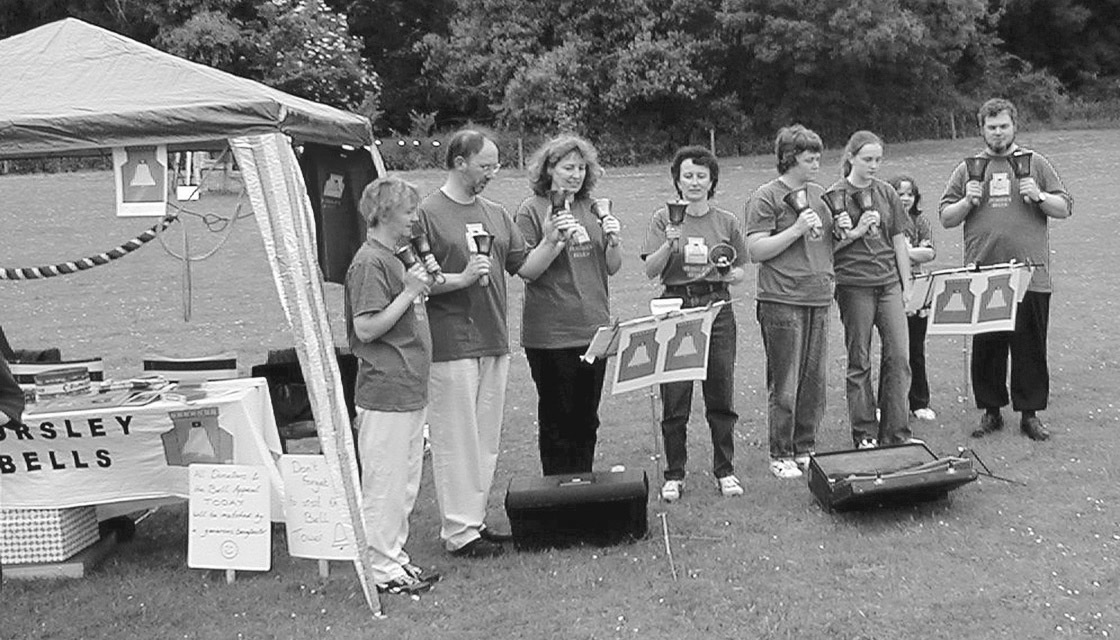 |
Originally there was no intention to augment the ten. However, during the fundraising period a local businessman made an extremely generous offer to donate two trebles to make the ring up to a twelve. After some discussion this was gratefully accepted by the PCC, and fresh plans were drawn up. Both bell-hanging firms suggested that all twelve bells would fit on one level. However there was some concern among the village community that the upper frame, installed in the augmentation to ten in1989, would no longer be used. This might offend the people who had donated to that appeal. This concern eventually led to the PCC making the decision to use a ‘three up and nine down’ solution that would utilise an extended 1989 frame (hanging the 6, 7 and 8 of the twelve in the upper level).
Whitechapel were awarded the contract and they cast the two new trebles in January 2006; luckily a few of the ringers were able to accompany the Churchwardens and some parishioners to see this exciting event. The final ringing on the ten was a local band peal of Yorkshire Surprise Royal on the 17th of April and the bells came out the next day to be transported to the Whitechapel Bell Foundry. Here the tuning of the ten bells was checked, and for several bells improved, and the new framework made and assembled - earning a mention in the same column as Big Ben in a Daily Mail article by Roy Hattersley. The bells and new fittings, together with the frame, returned on Tuesday the 20th of June.
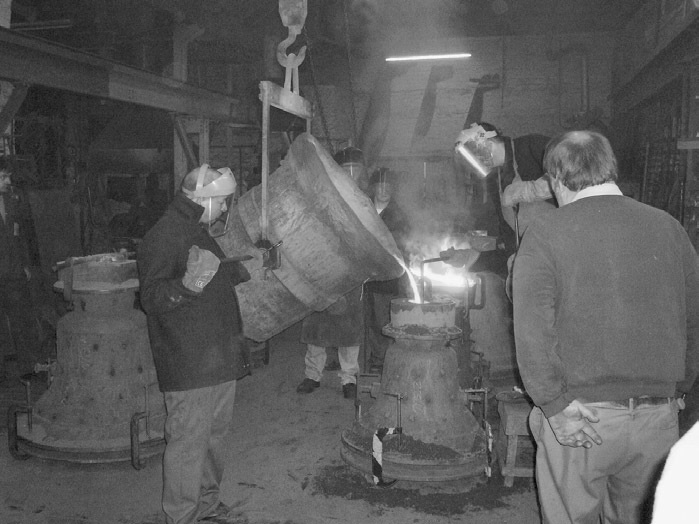 |
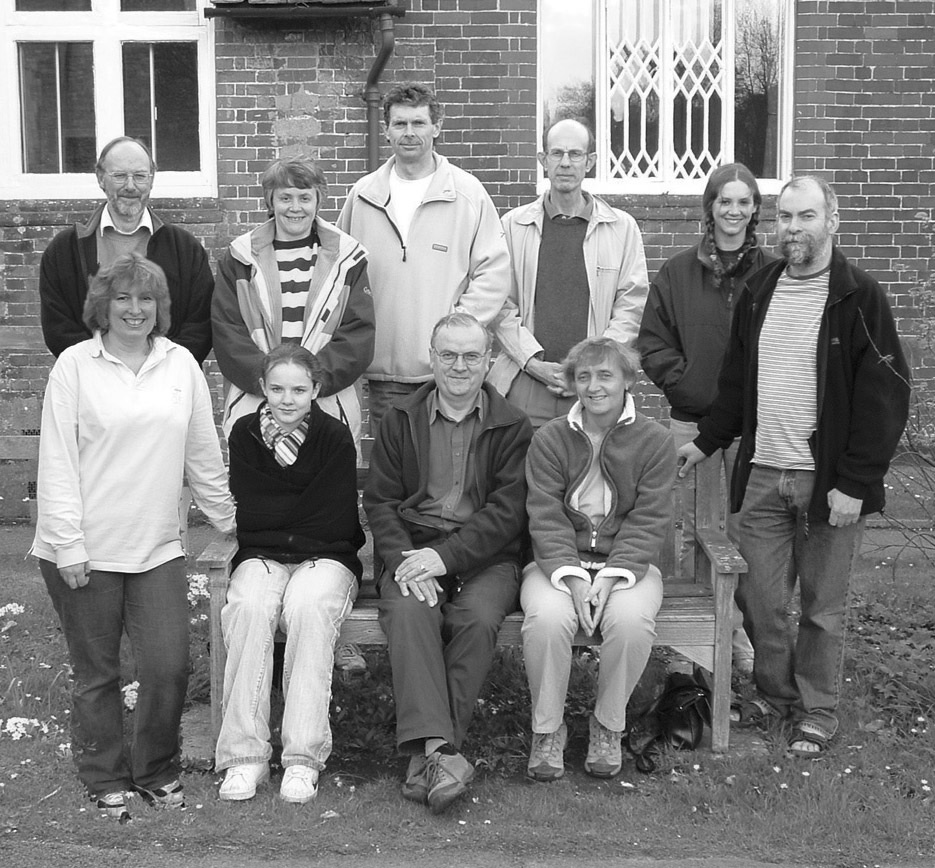 |
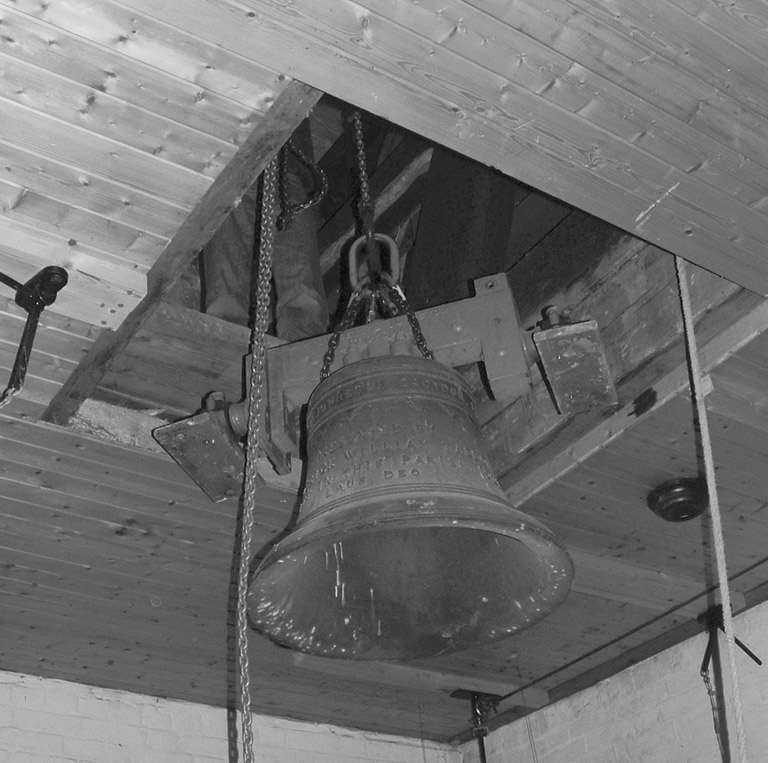 |
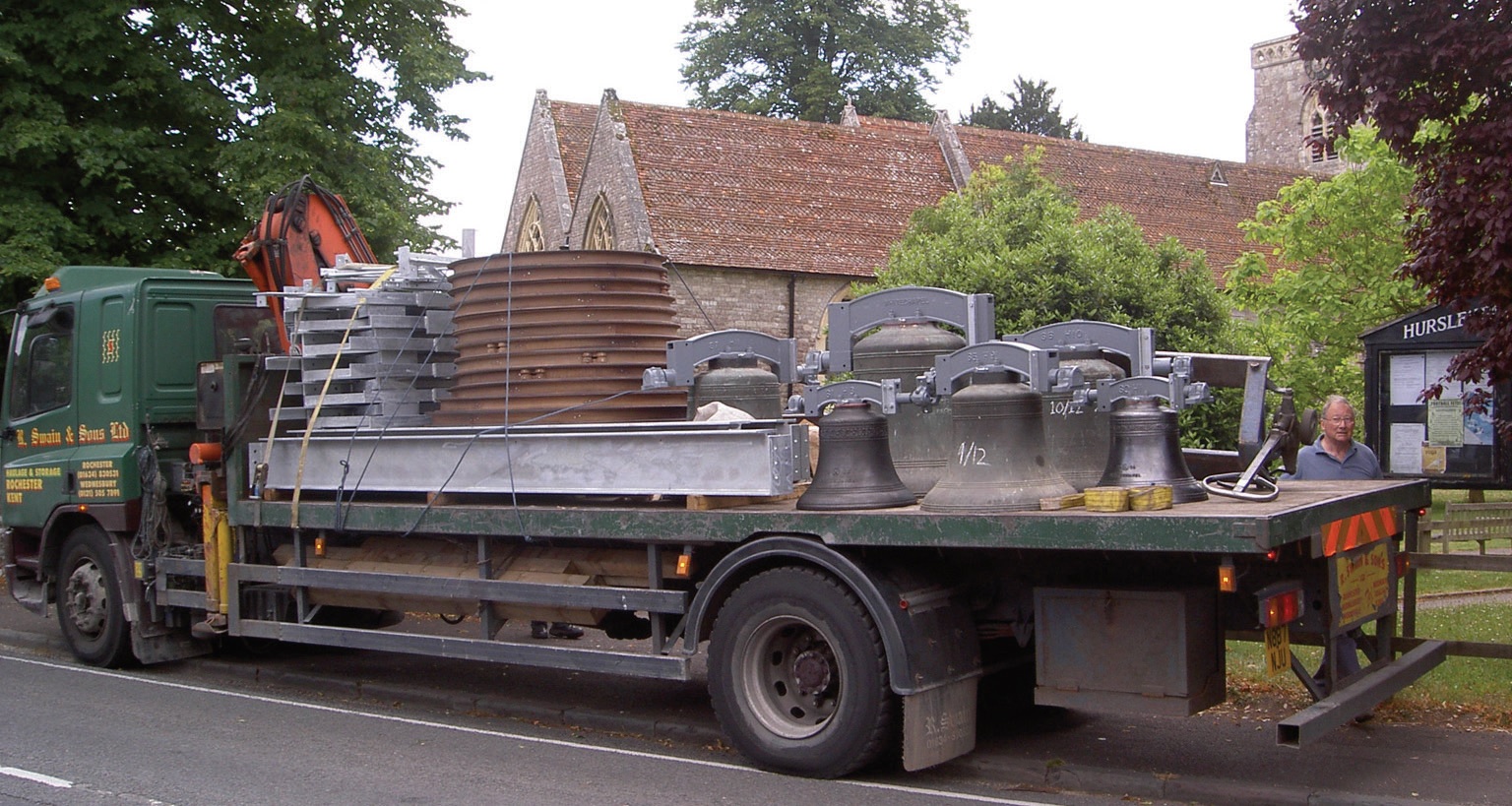 |
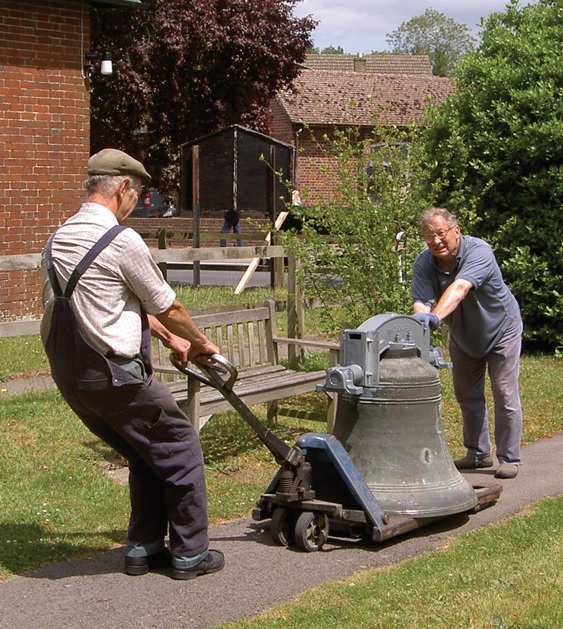 |
Despite the heatwave conditions, Neil Thomas from Whitechapel, assisted by local bell hanger Martin Waldron, got the bells ready to ring by mid-August. The try-out was on Thursday, 24th August by the local band and friends, in the presence of the donor of the two trebles, and the twelve were agreed to be very fine and ringer-friendly.
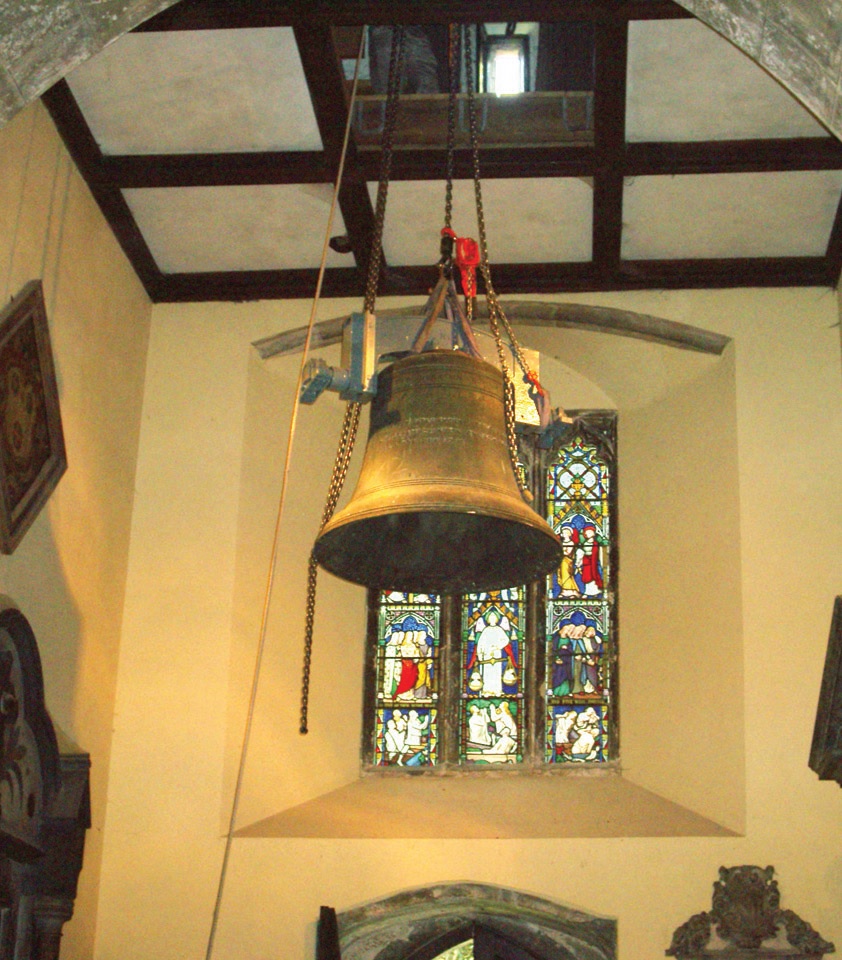 |
A congregation of about seventy ringers and non-ringers attended the dedication of the two trebles on Saturday, 21st October. Despite it being half-term and several ringers being away on holiday, including the Tower Captain, the ten bells were rung prior to the service, and the twelve rung afterwards, by a Hursley Sunday service band.
During the Dedication Service Martin Waldron gave a brief history of the bells at All Saints. The W&P Guild Master Andrew Craddock (also a member of the Hursley band) read the lesson. The Bishop of Winchester, despite admitting to not being a ringer, gave an interesting address where he displayed a sensitive awareness to the art of change ringing. Handbells were then rung by a Hursley band whilst the Bishop ascended the tower to bless the bells.
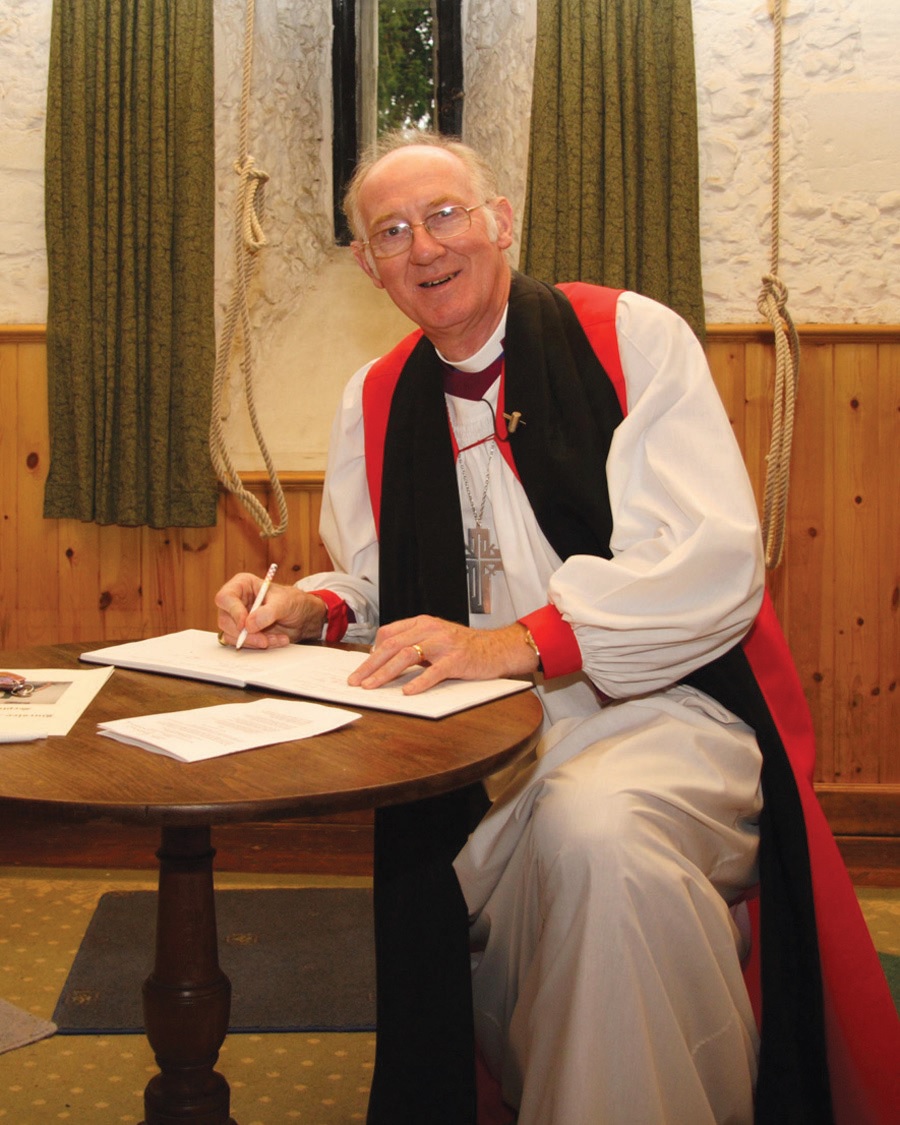 |
After the service the congregation was entertained to tea and some excellent cakes in the Parish Hall; ringing on the twelve continued and the local band was joined by some of the ringers and non-ringers who had attended the service.
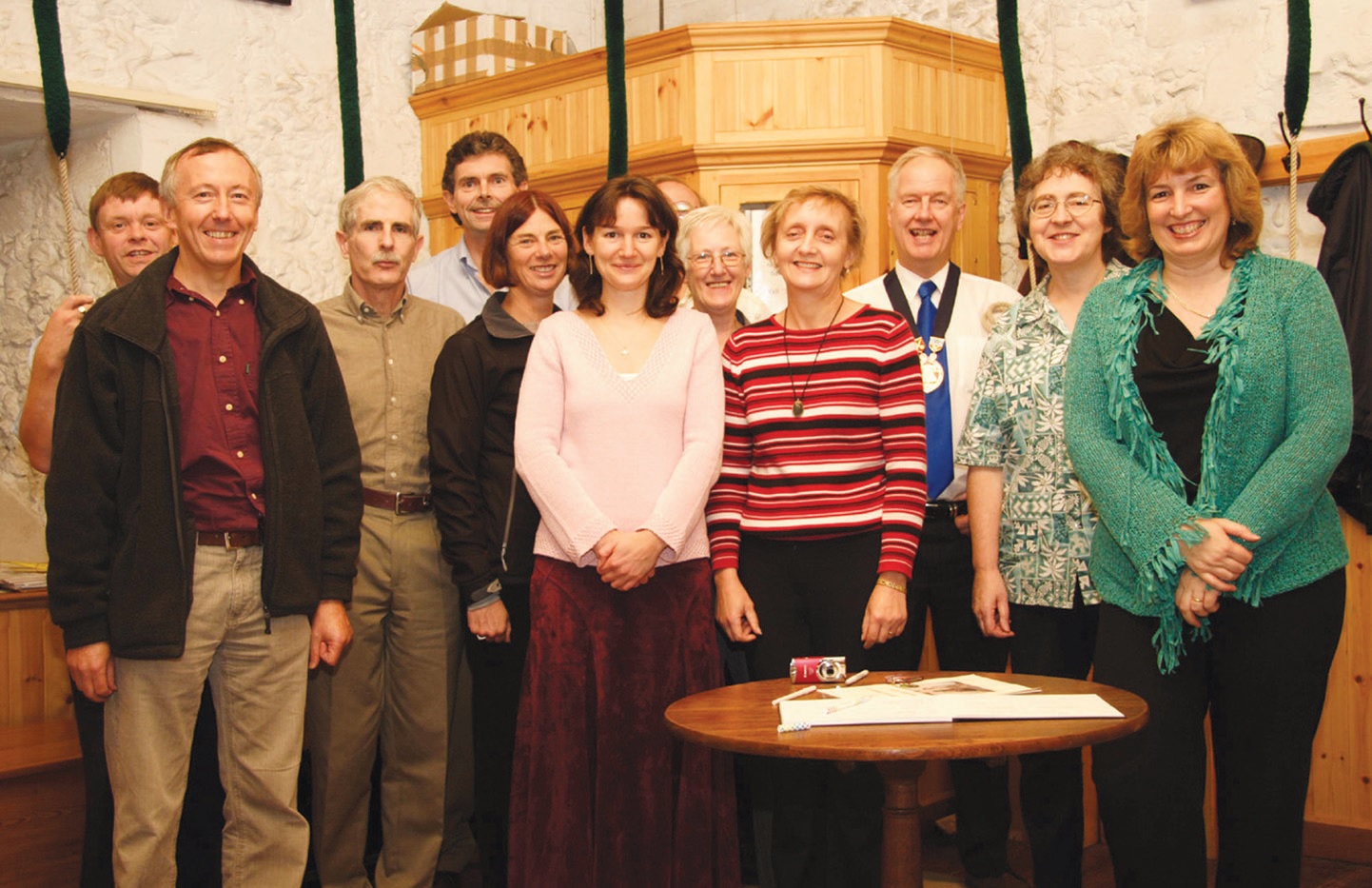 |
On Sunday, 22nd October a Sunday Service band rang the first quarter on the twelve for evensong; 1276 Grandsire Cinques conducted by Tony Smith:
1 Christine Saunders, 2 Maureen Hanney, 3 Ken Warner, 4 Jenifer Smith, 5 Ian McCallion, 6 Tony Smith, 7 Janice Higgins, 8 Pam Thompson, 9 Mac McTiffin, 10 Richard Thompson, 11 Andrew Craddock, 12 Russell Jordan.
The first peal on the twelve was rung on the following Saturday (see report on p.1102).
After an augmentation the question is often asked whether the local band will cope with ringing on higher numbers. Hursley was lucky in starting with a very strong ten bell band and although few members are lucky enough to live in the village, the majority come from within a catchment area of about a six miles radius and many have long standing connections with the village.
At the time of the augmentation to ten there was a competent band which quickly adapted to ten bell ringing. The first peal on the ten was Grandsire Caters, with the band containing eight local ringers plus Andrew Craddock (who subsequently joined the Hursley band) and Roy LeMarechal. Two of the local band, Brian Lovelock and Philip Belgeonne were ringing their first peal. The last peal on the ten bells was rung on Easter Monday, 2006, and the entirely local band contained Tony Smith and Michael “Mac” McTiffin, who both rang in the first peal on the ten.
Since 1989 Winchester and Portsmouth Guild reports show a large turnover of ringers, but the band has remained consistently strong, both by developing its own ringers and by attracting ringers moving to the area. Tony Smith, who has been a member of the band for many years attributes its success to a policy of always welcoming ringers who wish to join the band, no matter how regularly they attend. This policy has also resulted in a very sociable band, and there is a regular programme of ringing and non-ringing events, including a Christmas dinner, summer barbecue, cycle and car outings and New Year’s Eve party.
The tower’s ringing records for the last fifteen years show a steady development both in terms of complexity of methods rung, and in personal development for many of the ringers. Hursley has a well deserved local reputation for a high standard of ringing, and this is reflected in the peal records. A mainly local band rang the first ever peal of Hursley Delight Royal in 2002, and between 2004 and 2005 seven local ringers, including 14-year-old Katie Hill, rang their first peals of eight Spliced Surprise Royal. The light bells enable comparatively young children to learn, and a number have gone on to ring quarters and peals and become competent ringers on higher numbers. Of more recent recruits, Andrew Dodd and Rosemary Hill both rang tower bell peals at the age of 9, while Katie Hill and Stephen Thompson rang their first peals on 10 bells, and Kelly Salter called her first peal, Plain Bob Major in hand, at the age of 15.
The mid to late 1990s saw a peak in attendance numbers at practice nights when it was not uncommon to have 25-30 ringers, in a small chamber and ringing from Plain Bob Doubles up to Spliced Surprise Royal, posing quite a challenge for the Tower Captain. Hursley is fortunate in having a number of conductors and ringing masters in the band which, with regular rotation of those holding office, leads to an interesting variety in ringing, and occasionally in opinion! There are very few occasions when Sunday Services at All Saints are not rung for. In addition, most of the band actively support the Winchester and Portsmouth Guild, attending events and taking part in striking competitions, in which Hursley achieves a high success rate. The band also provides a regular supply of District and Guild Officers and many members regularly support other local towers.
It was probably predictable that the Hursley band would not be idle while the bells were away. Most ringers supported Sunday Service ringing at other local towers, and a programme of events was arranged to keep the band together. In order to hone our twelve bell ringing skills, visits were arranged to Winchester, Trowbridge and Reading and several members of the band scored their first quarters of Surprise Maximus. This has paid dividends, and the first practices on the twelve have included some very competent ringing by the local band.
We are very grateful to all the towers who accommodated us during our period of ‘homelessness’ and on our outings, and look forward to making visitors welcome at Hursley. Those who have previously attended practices at Hursley will appreciate, however, that they get quite crowded. If prospective visitors would phone the Tower Captain, Peter Hill on 01794 518068 in advance it would be very helpful and might save you a long journey to find no room in the tower!
CHRISTINE HILL
(With thanks to the other members of the band for their help and contributions of photographs)
| Bell | Diameter | Note | Weight (cwt) | Date | Founder |
| Tenor | 3’6" | F# | 13-3-26 | 1923 | Gillett & Johnston |
| 11th | 3’1" | G# | 8-0-22 | 1616 | John Wallis, Salisbury |
| 10th | 2’9½" | A# | 6-2-7 | ||
| 9th | 2’5½" | B | 4-0-22 | 1835 | William & John Taylor, Oxford |
| 8th | 2’5" | C# | 4-0-19 | ||
| 7th | 2’3" | D# | 3-3-16 | 1923 | Gillett & Johnston |
| 6th | 2’1½" | E# | 3-2-16 | ||
| 5th | 2’1" | F# | 3-2-17 | ||
| 4th | 2’0½" | G# | 3-2-21 | 1989 | Whitechapel Bell Foundry |
| 3rd | 1’11½" | A# | 3-1-27 | ||
| 2nd | 1’11" | B | 3-1-8 | 2006 | |
| Treble | 1’10" | C# | 3-1-18 |
The Ringing World No. 4986, November 17, 2006, pages 1093 to 1094 and 1096 to 1097